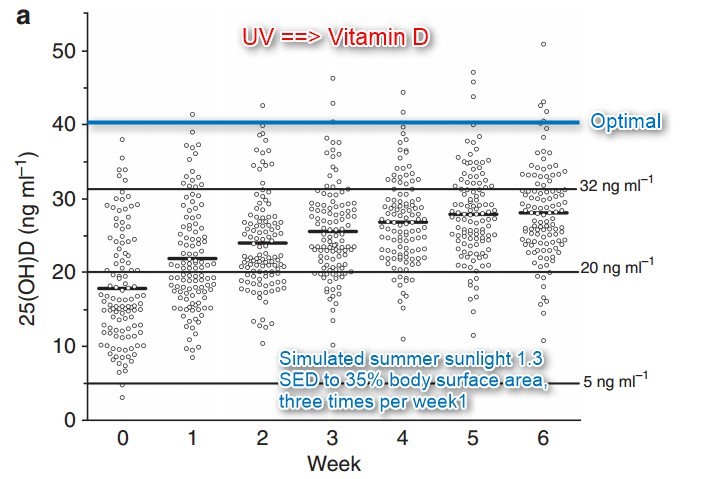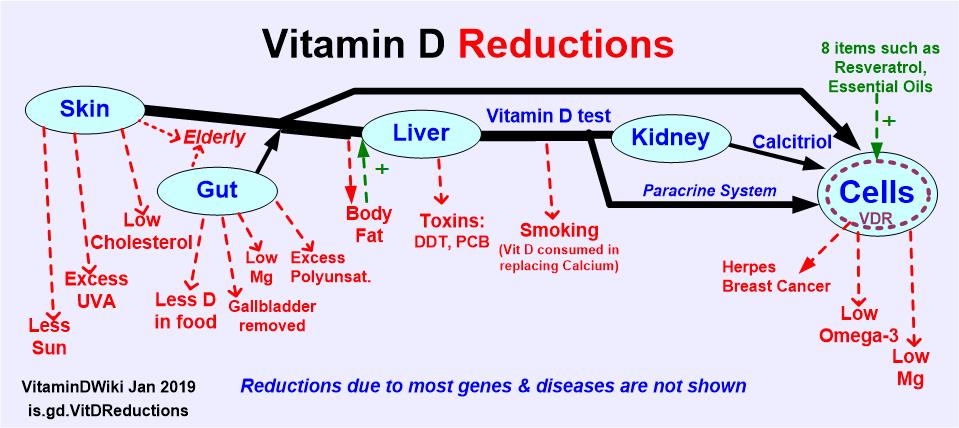Large variability in response to UV (more than response to oral Vitamin D)
Major inter-personal variation in the increase and maximal level of 25-hydroxy vitamin D induced by UVB
Photochem. Photobiol. Sci., 2016,15, 536-545. DOI: 10.1039/C5PP00462D
Pameli Datta,*a Peter A. Philipsen,a Peter Olsen,a Bibi Petersen,a Peter Johansen,b Niels Morling b and Hans C. Wulf a
- Corresponding authors
A Department of Dermatology, Copenhagen University Hospital, Bispebjerg Hospital, Bispebjerg Bakke 23, 2400 Copenhagen NV, Denmark, pameli@mail.dk
B Section of Forensic Genetics, Department of Forensic Medicine, Faculty of Health and Medical Sciences, University of Copenhagen, Frederik V's Vej 11, Teilumbygningen 5030, 2100 Copenhagen, Denmark
 Person #6 got the least benefit from the UVB
Person #22 got the most benefit from the UVB
About a 10X difference in responses
Note: This study was done in the winter, when the skin is not "expecting" to generate vitamin D.
See also VitaminDWiki
* Reasons for low response to vitamin D
* probably ~half of the 50 reasons for low oral response also apply to low UVB response
* Predict Vitamin D **category listing has items along with related searches** and has the following chart
Person #6 got the least benefit from the UVB
Person #22 got the most benefit from the UVB
About a 10X difference in responses
Note: This study was done in the winter, when the skin is not "expecting" to generate vitamin D.
See also VitaminDWiki
* Reasons for low response to vitamin D
* probably ~half of the 50 reasons for low oral response also apply to low UVB response
* Predict Vitamin D **category listing has items along with related searches** and has the following chart
 * UV production of Vitamin D varies with the individual – 2010 has the following chart
* UV production of Vitamin D varies with the individual – 2010 has the following chart

📄 Download the PDF from Sci-Hub via VitaminDWiki
Vitamin D influences skeletal health as well as other aspects of human health. Even when the most obvious sources of variation such as solar UVB exposure, latitude, season, clothing habits, skin pigmentation and ethnicity are selected for, variation in the serum 25-hydroxy vitamin D (25(OH)D) response to UVB remains extensive and unexplained. Our study assessed the inter-personal variation in 25(OH)D response to UVR and the maximal obtainable 25(OH)D level in 22 healthy participants (220 samples) with similar skin pigmentation during winter with negligible ambient UVB. Participants received identical UVB doses on identical body areas until a maximal level of 25(OH)D was reached.
Major inter-personal variation in both the maximal obtainable UVB-induced 25(OH)D level (range 85–216 nmol l-1, mean 134 nmol l-1) and the total increase in 25(OH)D (range 3–139 nmol l-1, mean 48 nmol l-1) was found. A linear model including measured 25(OH)D baselines as personal intercepts explained 54.9% of the variation.
By further including personal slopes in the model, as much as 90.8% of the variation could be explained. The explained variation constituted by personal differences in slopes thus represented 35.9%.
Age,
vitamin D receptor gene polymorphisms,
height and
constitutive skin pigmentation (a skin area not exposed to UVB)
explained 15.1% of this variation.
Despite elimination of most known external sources of variation, our study demonstrated inter-personal variation corresponding to an observed maximal difference of 136 nmol l-1 in the total increase of 25(OH)D and 131 nmol l-1 in the maximal level of 25(OH)D.
Notes from the PDF
They used a broad spectrum light. 290-350 nm (both UVB and UVA)
The UVA could decrease vitamin D differently between individuals
Important variables
Age, (22-62)
Weight (60-100 kg)
Height (160-190 cm) – taller = more skin area ==> more VitD
Body mass index (21-30 kg/m2)
Gene: rs1544410 (AA/GG/AG)
Skin color (participants had a narrow range of skin color)
Variable which were not as important
Gender
Fatty fish intake (0-5 meals/week)
Equation

Note: This small study did NOT consider differences due to:
poor liver
low cholesterol diet
toxins
smoking
Iron level
Differences can be very important for such a small study

click on chart for details
